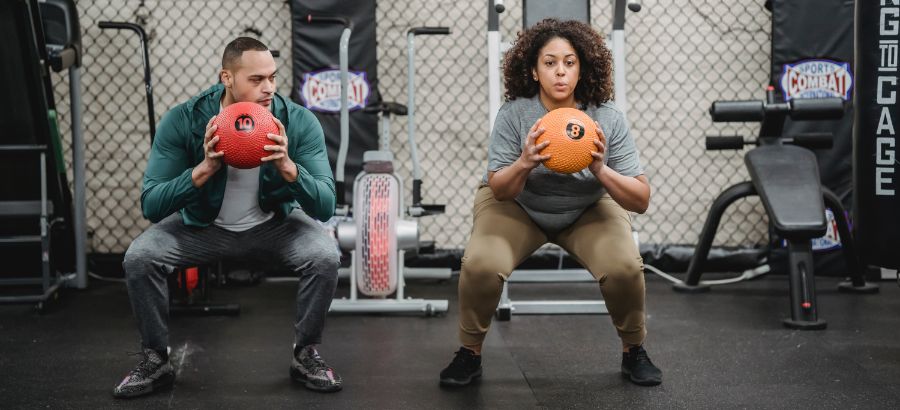Blog
ONLINE TRAINING
EXPERT TRAINERS
STUDY AT YOUR PACE
7 DAY SUPPORT

Exercise Highlight: What you need to know about squats
The squat is often considered one of the most important and beneficial exercises in a person’s program. Not only does this exercise target the thighs (quadriceps and hamstrings) and glutes, but core strength, stability, ankle mobility, and back strength are also needed. When conducted correctly, the squat can help to prevent injuries, strengthen the core, improve balance, and help to create better posture.
However, it is important to understand that some people will squat differently from others. For example, while some of us are born with the ideal bone structure for deep squats – some of us are not; and that’s okay. You may be under the impression that during a squat, your toes must be pointed straight ahead and your feet shoulder-width apart. However, this is not always the safest and most suitable stance for every person.
There are two main factors that determine how a person squats, including:
- Mobility – refers to the flexibility of soft tissues and how it affects movement. When our tissues become shortened or stiff, they can influence a person’s ability to move fluidly
- Anatomy – refers to the way bones are formed and aligned. It is important to understand that every person will have a different bone structure and biomechanics
For further reading, this resource provides further information about how anatomy and mobility affect squat mechanics: HOW HIP ANATOMY AFFECTS SQUAT MECHANICS

When working in the fitness industry, it is your responsibility to conduct a pre-exercise screening test with your clients. Often, this will include a screening form and fitness appraisal. As part of your appraisal, you may ask your clients to complete a squat to the best of their ability, allowing you to identify potential problems or modifications. If an issue is detected, it is best to conduct a functional movement assessment. If you feel that you don’t have the correct skills, knowledge, or qualifications to do this, you may need to refer your client forward.
Screening will often start by assessing the amount of rotation available at the hip joint. Asking the client to lie on their back will allow you to see how much internal rotation (foot moving away from the body) and external rotation (foot moving towards the body) they possess. While this assesses possible mobility restrictions, it doesn’t help to clearly identify anatomy issues. If you notice a large difference in the amount of internal vs external rotation, you need to assess what’s going on inside the hip joint.
To do this, you can ask the client to lie on their stomach with their knees bent at a 90-degree angle. Then, you must rotate the client’s leg internally and externally. As you rotate the leg, you should aim to identify the prominence of the femur notch against your hand. Stop moving the lower leg when you identify the most prominent position.
Ideally, the lower leg will point slightly away from the body; within 15 degrees of a vertical position. If the leg is positioned at a wider angle, your client may have an anteverted hip. In this case, you need to encourage the client to modify their stance to ensure comfort. Those who try to conform to an unnatural squat stance will feel a hard blocking sensation or a pinching pain; this is regardless of how much mobility work they conduct.

It is your job to help your clients find their perfect squat stance. They must understand what works for their body and make the right adjustments to ensure they remain pain-free. There are many squat variations that can be considered, including:
- Wall squats: can be completed if you stand with your back against a wall and place your feet approximately 12 inches from you. From there, bend into the squat position while keeping your back pinned to the wall, and repeat. This is beneficial for those who have knee problems, hip problems, or need extra support
- Plié squats: can be completed if you stand with your feet wider than shoulder-width apart, toes pointed outwards. Once in position, bend your knees until your thighs are parallel to the ground, or as far as possible. This exercise is not only modifiable to personal ability but is great for targeting the hips
- Overhead squats: is completed with a weight held above your head. To complete the exercise, you must stand with your feet wider than shoulder-width apart, toes pointed out, and arms completely upright holding a weight. You must keep your chest and head up, sit back into your hips, ensure your thighs are just past parallel to the ground, and repeat. This exercise requires more flexibility, mobility, and stability than the basic squat
- Squat jumps: can be completed by standing with your feet shoulder-width apart and knees bent into a full squat position. Then, engage the quads, glutes, and hamstrings to jump into the air. Control your landing and then squat again for another explosive jump. Targeting the lower body muscles and core, this type of squat is beneficial as it improves agility, power, and the vertical jump
- Goblet squats: is completed with a dumbbell or kettlebell held in front of your chest. Keeping your core tight, back straight, and weight in contact with your body, bend at the hips and knees to start the squat. Keep going until your elbows touch your knees (or until you lose the neutral spine), stand up, and then repeat
As always, the main thing to keep in mind when introducing a new variation to a client is ensuring that all exercises align with their goals and programs!
Our Nationally Recognised Courses
Australian College of Fitness and Personal Training
PO BOX 15367, CITY EAST QLD 4002Registered Training Organisation Number: 45361
